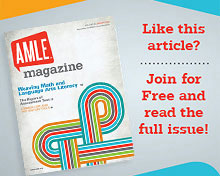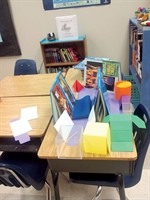Middle school students are growing and developing into actively thinking young adults. To become critical thinkers who take ownership of their work, they need guided autonomy embedded in rich learning experiences. This kind of instructional model is valuable for all students and, in my experience, it’s especially valuable with special education students.
How do we get there? In any kind of learning environment, students respond best to guided autonomy that includes real-world dynamic learning, opportunities for higher-order thinking, and supportive relationships.
Guided Autonomy

After years of dealing with students jumping up out of their desks to go to the bathroom or grab a book during independent reading time, I realized that students need a clear idea of what’s allowed in terms of free movement. Setting classroom parameters within the first week of school and reinforcing them throughout the first month or more makes for a more productive classroom and happier students. The key is student autonomy and self-guidance.
In the classroom. Allowing students to sit where they want at specified times builds student autonomy. Allowing free movement when you are not directly instructing builds student autonomy. My students learned that I was not the classroom dictator and that they had some ownership of their surroundings.
It was a joy to have an open classroom environment with 12 learning-disabled young adolescents. They learned to master flexible seating and knew where all the classroom supplies were located. They could access everything they needed without teacher assistance. But they still needed reminders—they were, after all, middle school students.
At my school, we enforced the 3Rs: respect, responsibility, and responsiveness in the learning environment. I reinforced these from the beginning with as many reminders and classroom discussions as needed. I also posted my expectations for classroom behavior for all to see, keeping the expectations simple and focused on personal dynamics.

Why have students explain the physics of a golf course when they can show it to you with hands-on projects?
In the learning process. Student autonomy in the learning process is also important. We outlined the process for finding the answer when they were struggling to solve a problem: do online research, consult a textbook, ask a classmate, ask the teacher.
A consistent lesson format that included autonomy-building activities also was effective. Students learned to use textbooks and online tools so they could navigate them independently. Question prompts such as “Where do you find that in the text?” “What do you think about the author’s perspective?” “What advice do you have for your classmates to help them find the answer?” helped.
Understanding how to address multiple-choice questions is also an important skill. Students were encouraged to explain how they chose their answers; for example, “I eliminated this answer because…”, “Both of these answers work well, but I think this one is better because….” I also enjoyed answering their questions with “I don’t know,” prompting them to remember how they, themselves, could find the answers.
They worked together to solve problems, repeating instructions aloud to each other and then going through the problem-solving process we had outlined: do online research, consult a textbook, ask a classmate, raise my hand. Notice that the teacher is last in the chain.
Once my students learned to learn independently, I intervened only as needed. When they made mistakes, they took command of their mistakes, solved the problems, and moved on, because they had learned that was the way to do it. All of this was in the context of real-world, dynamic learning.
Real-World Dynamic Learning
Real-world learning is necessary if students are to become real-world questioners, participating in real-world exercises that help them grow as individuals.
In the real world, individuals team up to learn. Daily group activities taught my students to work together and allowed them to ask deep, searching questions. No question, if related to the topic, was wrong, so long as it was delivered respectfully.The sixth graders learned to rely on each other’s strengths and think explicitly to augment their own learning styles and differences.
Old world: A student is valued who can find the right answer.
New world: A student is valued who can think independently.
Higher-Order Thinking
A strength of our young adolescent population is their creative, innovative spirit. This isn’t fostered in nearly enough classrooms. If we don’t teach students to be creative thinkers and questioners, we doom them to a life of traditional thought and underdeveloped potential.
Memorization and regurgitation are not the same as understanding and knowing conceptually.
Old Teaching and Assessment
- Science: Memorize biotic and abiotic factors.
- History: Memorize the important events leading to World War II.
New Teaching and Assessment
- Science: Identify biotic and abiotic factors in a terrarium; transfer this knowledge to correctly identify biotic and abiotic factors in a printed environment in a textbook.
- History: Understand and explain the contributing factors and trends in each event leading up to World War II.
Some students learn well through memorization and then jump to conceptualization once their brain has more fully developed—a traditional progression from small to large. However, instruction and assessment that focus on memorization can inhibit big-picture thinkers from learning and growing. Yes, memorization is part of learning in the work force, but employees who are not able to put into practice that which they have memorized may struggle to succeed.
Alongside learning activities that build big-picture, higher-order thinking, students must build supportive relationships with their teachers.
Supportive Relationships
Students need to know that their teachers are on their side. Brief classroom meetings can build camaraderie. Games can bond a learning team. A teacher’s apology for making a mistake or hurting a student’s feelings goes far toward building supportive relationships and promoting learning.
Parent communication also builds relationships with students. Send positive feedback home, particularly for your most difficult students. You’ll see a shift of attitude from both disgruntled parents and disruptive students as a result of positive and constructive feedback.
Joyful Learning
Minds-on, hands-off learning builds a classroom culture of student autonomy within a supportive environment. Combine that with extensive planning and frequent communication and the reward will be increased student engagement and a joyful world of learning.
Alicia A. Cole, an education writer and specialist student in educational psychology at the University of Connecticut, was a teacher and special education coordinator for 10 years. alicia.cole@uconn.edu
Published in AMLE Magazine, January 2015.
